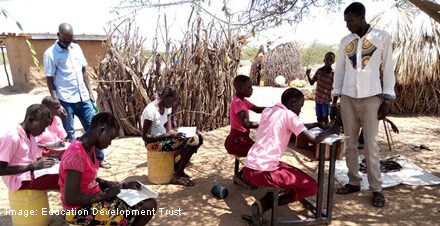This blog was written by Mary Burns, Education Development Center.
Is online learning inherently inequitable? Such a nettlesome question lays bare one of online learning’s most long enduring Achilles Heels—that it benefits learners with significant financial and educational advantages while neglecting the poorest and most educationally disadvantaged ones.
For many of the world’s learners, online learning can be transformative—offering access to high-quality learning opportunities unavailable locally. But for many more learners who lack access to infrastructure and digital devices, online learning’s benefits are more suppositional than real. The very essence of online learning, with its demand for crucial and unevenly distributed physical, human, technical, and educational inputs, perpetuates and exacerbates existing educational disparities and results in the educationally rich getting richer while the educationally poor get poorer.
Education Development Center’s Distance Education for Teacher Training: Modes, Models and Methods, which I authored, wades into this discussion of equity in online learning—and this post builds on this newly published guide’s examination of the longstanding equity challenges in online learning. While advocating for online learning as a valuable tool for adult education, especially for pre- and in-service teachers, this post, and the guide it draws from, shed light on lesser-known yet significant inequities and proposes strategies for their mitigation.
Equity defined
Equity is a term spawning much debate and little consensus. In this post, I adopt definitions proffered by UNESCO’s Sustainable Development Goal 4 and the OECD. According to these sources, equity encompasses the provision of quality and inclusive professional learning opportunities to individuals who need them most. Learning that is truly equitable ensures that learner performance is not influenced by their background or by socioeconomic circumstances beyond their control.
A feature not a bug: Exploring online education’s equity dichotomies
Labelling online education as “inherently” inequitable may initially seem rhetorically unusual, but in fact its many disparities are deeply intertwined with its design and delivery. To gain a deeper understanding of this issue, let’s explore the two fundamental pillars of online learning: synchronous and asynchronous learning. Although these approaches offer numerous benefits, they often impose limitations that impede equity and, in certain cases, even undermine it entirely.
Asynchronous courses
Asynchronous courses, for instance, boast the benefits of “any time, any place, any pace” learning ostensibly benefitting learners balancing work and study, those burdened with family responsibilities that prevent them from adhering to fixed course schedules, and those with limited access to high-speed internet (like many teachers in the Global South). Yet, research shows that asynchronous courses, especially self-paced ones, negatively impact the attendance and achievement of more economically and educationally disadvantaged learners.
These learners bear the brunt of low completion rates—that is, high attrition or drop-out rates. This disparity disproportionately affects traditionally underserved groups, including female learners and those in low-resource contexts. Studies conducted on Massive Open Online Courses (MOOCs) demonstrate that learners in Africa, Asia, and Latin America, as well as female learners, achieve significantly lower grades and are only half as likely to complete their courses compared to their counterparts in Europe, Oceana, and North America, or male learners.
Asynchronous courses suffer from additional issues that perpetuate long-standing inequities. Many of these problems stem from the market-driven nature of technology itself and digital content development. For instance, online programmes may necessitate the use of costly digital content and software that schools or teachers cannot afford. Learners often find themselves accessing digital content in languages they cannot comprehend, while courses may lack accessible designs or fail to incorporate even the most basic accessibility features. (Open education content helps with this but not at the scale imagined).
Moreover, due to the absence of instructors, learning activities and assessments are frequently simplified or abridged, depriving learners of the opportunity to engage with complex concepts and resulting in a diluted learning experience. Poor bandwidth results in online courses being shaped not by desired learning outcomes or the benefits of interactions with content, but rather by the limitations of technical infrastructure. Consequently, in low-bandwidth environments, online courses often become mere digital replicas of traditional paper-based learning, failing to capitalise on the affordances of online learning and failing to effectively engage learners.
Synchronous courses
One might assume that synchronous courses fare better in terms of equity, but they too promote their own set of inequities. In addition to demanding greater bandwidth and adhering to fixed schedules, which disadvantage those who work full-time or have caregiving responsibilities, synchronous courses may be content-lite or rely heavily on didactic instruction, thereby fostering learner passivity. Most damagingly, synchronous courses frequently feature instructors who are unqualified or inadequately prepared to teach—online or in person. Traditionally disadvantaged adult learners, like their younger charges, are often most exposed to and more disproportionately negatively impacted by poorly trained instructors.
Let them eat cake
There are attempts to redress the above challenges. For example, many online programmes opt to develop micro-courses for teachers’ mobile phones (versus providing teachers with laptops and internet access like their counterparts in wealthy contexts). This “separate but equal” hardware solution certainly seems an intuitive enough workaround, but again we witness how the equity challenges of online learning surpass simple technical or mechanical solutions. Learning through mobile phones, with their limited screens and keyboards, places a heavy cognitive load on learners as a result of excessive scrolling, squinting to see other learners, and frequent interruptions such as text messages. Paradoxically, in the pursuit of making online learning more accessible, designers end up sacrificing quality, a key component of equity. Micro-courses often oversimplify content, while online courses designed for phones frequently neglect essential activities like reading and writing, which are integral to effective (online) learning. Such design decisions compromise the overall learning experience, particularly for individuals who require the highest standard of education, such as unqualified teachers or those teaching outside their content areas.
Despite these issues and despite teachers’ stated concerns and frustrations about the inadequacies of phones for online courses, the practice of shoehorning online courses onto mobile phones continues unabated.
Toward equity in online learning
While online learning promises broad access, inclusivity, and quality education for those lacking in-person options, it often results in exclusion for those most in need of all of these. These inequities often mirror, and deepen, larger educational and socio-economic disparities. Thus, addressing these equity challenges will require a comprehensive approach rather than a single technological trajectory. A few such approaches are outlined here:
1. Focus on common sense and on the common good
Achieving equity in online learning requires more than just technical fixes; it demands a strong policy framework rooted in common sense access to devices, internet, software, quality local-language content, and well-trained instructors. This is foundational to equity.
However, equity must be rooted in a commitment to the common good. Investing in teacher education may be costly, but the societal benefits of developing excellent teachers far outweigh the expenses. Skilled and qualified teachers play a vital role in equipping students with the necessary knowledge and skills to thrive in the workforce, thereby contributing to a country’s economic growth.
Thus, policies, programmes, and implementation must be embedded within an education system that is responsive to the needs of marginalised communities, avoiding a one-size-fits-all approach for online learning for these teachers. To achieve this, policymakers, donors, and online educators need to grasp the local context, constraints, and opportunities by actively engaging with teachers and students in these communities. By championing equity and quality, investing in underserved communities, providing equipment and infrastructure, tailoring initiatives to local needs, setting standards, empowering educators, and fostering collaboration, education systems and the donors who fund them can forge a more equitable online learning landscape.
2. Purposefully design for equity
Those of us who accept bilateral and multilateral donor funding to provide online learning to the world’s teachers must reconceptualise our understanding of equity, and this recalibration must contain a quality imperative. Without the right people and practices, our efforts result in “equity” that is more notional and imitative than real.
Online programmes aiming to provide quality instruction to teachers and learners must intentionally design courses that address the needs of learners for whom online learning is an enormous paradigm shift. This involves skilled instructional designers and highly qualified online instructors who create blended and bichronous courses skillfully crafted to leverage the advantages of each modality while mitigating their adverse impacts for the most at-risk learners. Online programmes must equip learners with the necessary educational, emotional, logistical, and technical skills essential for success in an online endeavour. Achieving equity in online learning requires inclusive co-development with teachers in the Global South, offering content and experiences that align with their context, curriculum, language of instruction, and student needs.
Once again, all of these interventions are costly and time-consuming endeavours requiring substantial time and financial investments. They also demand a shift in focus of donor reporting and accountability mechanisms from the more performative counting the number of teachers trained to documenting observable and measurable impacts on quality learning.
3. Manage expectations around online learning
The disappointment with online learning, in part, stems from our tendency to view it, and perhaps all technology, as a universal solution for the financial and human resource problems that beset many education systems.
Yet online learning is not a panacea. It cannot fix underlying issues in teacher training programmes, such as recruitment and selection of unqualified teachers or low-quality pre-service and in-service education. Online interventions that deliver low-quality instruction simply perpetuate and scale inferior or mediocre programming. Success in online education initiatives hinges on developing a coherent and aligned education system that encompasses standards, high-quality curriculum and learning activities, assessments that accurately measure what teachers can do, supervision, and leadership. We have much work to do to achieve this level of coherence.
—
Final thoughts on equity
Equity is a process not a final product, it’s ongoing and continuous, not a one-time accomplishment. It is a commitment not a branding or business development strategy. It is expensive, time consuming, and human-resource intensive; it is not cheap, fast, or easy nor can it be attained by cutting corners, deploying untrained course designers and poorly prepared online instructors. It is inclusive and deliberative, not imposed or improvisational. Equity is a purposeful commitment to ensuring meaningful access to relevant, excellent learning experiences for those who need them most regardless of the obstacles they face and over which they have no control.
Reference
Burns, M. (forthcoming, July 2023). Barriers and Supports for Technology Integration: Views from Teachers. Background chapter prepared for the Global Education Monitoring Report: Technology and Education. United Nations Educational, Scientific and Cultural Organization.





